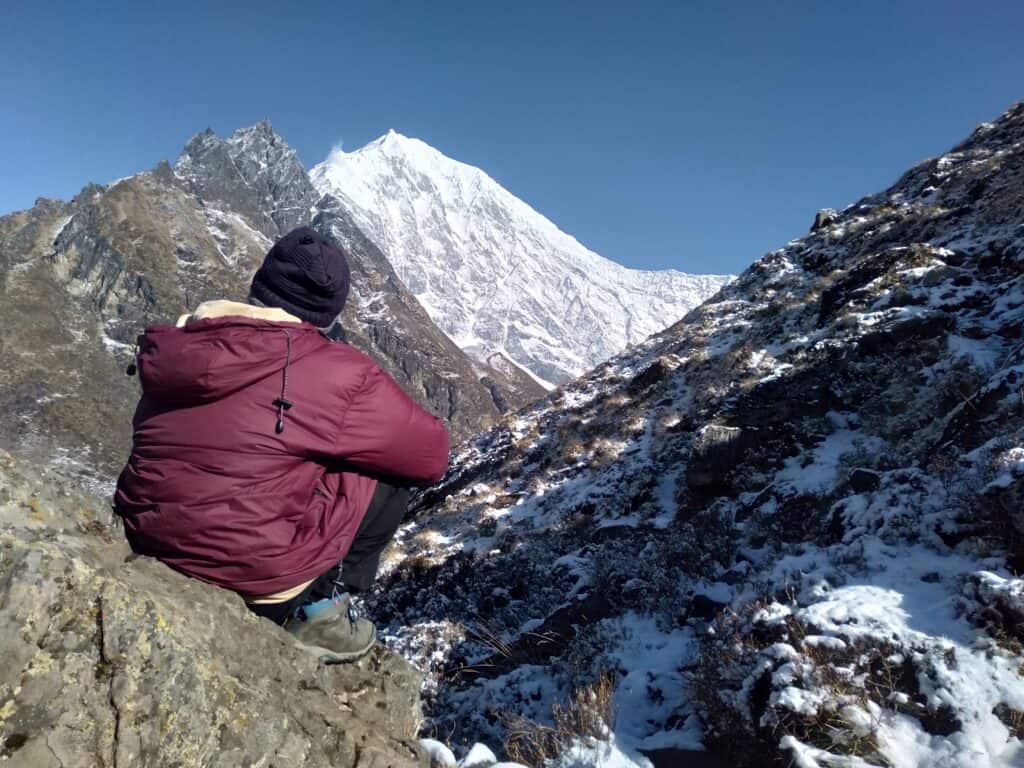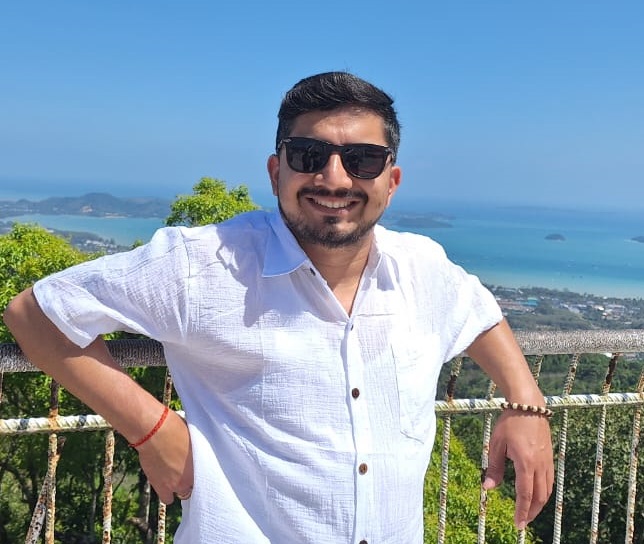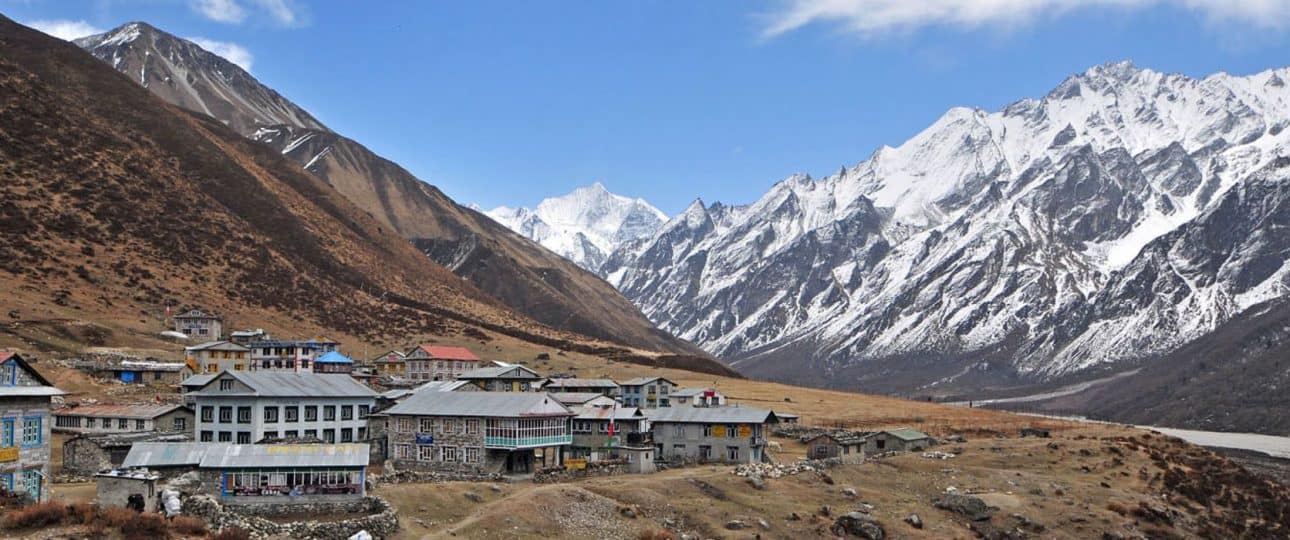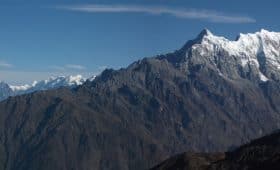The Langtang Region is among the most beautiful treks in Nepal.
And if you are here looking for the Langtang Trek Route, then look no further.
The alpine forest along the Langtang Trek route blooms with rhododendrons in the spring.
Yaks and mules are seen grazing on green pastures.
Buddhist prayers flags flutter around the shrines and Langtang Lirung glisten in the background.
There’s something special about this tranquil Langtang that people love to experience again and again.
Situated not so far from Kathmandu, on the Langtang Trek route, there is nothing that reminds you of the hustle and bustle of Kathmandu city.
This is how peaceful Langtang trek route is.
Untouched by the hectic lifestyle, you will meet friendly locals whom you will remember your entire life.
Table of Contents
- Main Highlights of Langtang Trek Route
- Places and Attractions along the Langtang Trek Route
- Syabrubesi: 1460 m
- Old Syabrubesi:
- New Bridge:
- Domen: 1670m
- Hot Spring (Pairo): 1770m
- Bamboo: 1970m
- Rimche: 2450m
- Lama Hotel: 2470m
- Riverside (Gumnachowk): 2770m
- Ghoda Tabela: 3020m
- Army Checkpoint:
- Thangshyap: 3200m
- Chyamki: 3230m
- Gumba Village: 3400 m
- Langtang Village: 3430m
- Mundu: 3550m
- Singdum: 3555m
- Kyanjin Gompa: 3870m
- Retrace Back
- Extension after the Standard Langtang Trek Route
- Two Most Popular Itineraries
- Challenges and Considerations
- Some Tips on Langtang Trek Route
- Final Words:
Main Highlights of Langtang Trek Route

- Views of Langtang Lirung, Yala Peak and more
- Langtang National Park
- Tibetan-influenced culture and lifestyle
- Trek through alpine forests
- Sights of yaks and mules grazing on pastures
- Buddhist shrines and Goombas
- Local cheese factory
- Friendly locals
Want more information? Send us your query, and our experts will get back to you within 24 hrs.
And if you extend your trek toward further destinations, here are some other highlights that you can explore on the Langtang trek route:
- Gosaikunda Lake
- Laurebina Yak Pass
- Helambu Village
- Tamang Heritage Homestays
Places and Attractions along the Langtang Trek Route
Langtang Valley Trek or any other treks around Langtang area starts from Syabrubesi – a town located in Rasuwa district.
You can reach to Syabrubesi from Kathmandu by bus, shared or a private jeep.
Around 7-8 hours drive through unpaved and adventurous Pasang Lhamu Highway takes you to Syabrubesi.
During the travel, you will be graced with amazing views of Himalayas, villages, some small towns etc.

Syabrubesi: 1460 m
Syabrubesi is the trailhead of Langtang Trek that lies at an altitude of 1460 meter.
There are many hotels for fooding and lodging.
There are also ATMs of Prabhu Bank and Nepal Investment Mega Bank.
So, before starting your trek, make sure you have all the essentials with you.
Old Syabrubesi:
A 20 mins walk from Syabrubesi takes you to Old Syabrubesi.
The village lies on the bank of Trishuli River.
It has a few tea houses with Internet facility.
Unlike other tea houses on the way, you can find non-veg items on the menu.
New Bridge:
Ascending further for an hour, you can reach New Bridge.
There is a tea house in New Bridge. You have to cross the suspension bridge to reach Domen.
Domen: 1670m
A further half an hour walk takes you to Domen.
Domen is a small village at the bank of a river where you find a small tea house with a vegetable plot.
Hot Spring (Pairo): 1770m
You trek for about 45-50 minutes on a trail including steep uphill to reach Pairo.
There are a couple of tea houses and a small pool where you can spend some of your time swimming and looking down the Langtang River.

Bamboo: 1970m
About an hour’s ascent from Pairo takes you to Bamboo.
Bamboo is a village having about half a dozen tea houses and vegetable gardens.
The village is comparatively larger than the ones you came across.
Rimche: 2450m
The trail from Bamboo to Rimche is steep uphill.
There are a few small tea houses in Rimche.
The eastern part of Rimche connects high trail of Sherpagaun.
The high trail starting from Syabrubesi passes through Khanjim(2235m) and Sherpagaun(2560m) to descend to Rimche.
20 minutes walk from Rimche takes you to Lama Hotel.
Lama Hotel: 2470m
Lama Hotel is a popular village among trekkers.
Most of the trekkers stay overnight at Lama Hotel with around two dozens of houses.
You can find around half a dozens of tea houses here.
The next morning after breakfast, you start your trek from Lama Hotel.

Riverside (Gumnachowk): 2770m
In the next morning, about an uphill walk from Lama Hotel takes you to Riverside.
Also called as Gumnachowk, Riverside has a couple of tea houses distant from each other.
Ghoda Tabela: 3020m
As you continue your trek for about 20 minutes, you reach to a tea house located near to a bridge.
About an hour trek from there takes you to Ghoda Tabela.
Ghoda Tabela, situated above 3000 meter offers travelers breathtaking views of Langtang Lirung.
Here, you can find a couple of tea houses and farms.
Army Checkpoint:
After few minutes walk from Ghoda Tabela, you reach to an Army Checkpoint.
Here, your TIMS card and Langtang National Park permit are checked and recorded.
Thangshyap: 3200m
You reach to Thangshyap after about 30-40 minutes walk from the checkpoint.
You can have your morning meal here. Although far away, Langtang Village is seen from Thangshyap.
Chyamki: 3230m
A further 45 minutes walk from Thangshyap through Tsarding takes you to a small village called Chyamki.
Here, you can find a few tea houses.
Gumba Village: 3400 m
As you walk for about 45 minutes from Chyamki, you reach Gumba Village where you find a few tea houses scattered around the village.
Langtang Village: 3430m
As you pass by Gumba Village, you walk through the huge landslide that swept away entire Langtang Village in 2015 earthquake.
New Langtang village is built a few meters away on the other bank of the landslide.
Langtang Village is the biggest village in this trekking region.
There are many tea houses and shops. Locals produce wheat, buckwheat, and potato in the field.
You can wander around the valley visiting the cheese factory, yak farms, pastures, and the landslide area.
You spend overnight in Langtang Village.

The next day from Langtang Village is comparatively shorter one.
The total trek hours is around 3-4 hours on the third day of your trek.
Mundu: 3550m
Half an hour walk from Langtang Village takes you to Mundu.
Mundu is a Sherpa hamlet with a few tea houses.
Singdum: 3555m
Singdum is another settlement 15-minute walk away from Mundu. Here are also a few tea houses where you can take short rests after sweating walks.

Kyanjin Gompa: 3870m
Kyanjin Gompa is a settlement with many tea houses, a few bakeries, and amazing surrounding.
Kyanjin Gumba – a Buddhist monastery lies a bit further up from the settlement.
Take a rest in Kyanjin Gompa.
As you are already above 3800 meters in altitude, let your body acclimatize to the changing environment.
During the day, you can dig into culture, tradition, and lifestyle of local people in Kyanjin Gompa.
You can taste locally made cheese and yogurt.
Or, if you want to trek more, you can hike to Tsergo Ri or Kyanjin Ri to get breathtaking views of Langtang Lirung, Yala Peak, Gangchhenpo, Rasngbu Ri and more.
[wte_trips_embedder_trips layout=”list” ids=”56″]
Retrace Back
Since Kyanjin Gompa is the farthest point of your trek to Langtang Valley. You then return via the same route next day through Langtang Village to Lama Hotel.
Since most of your pathways will be heading downhill, you will descend fast.
After an overnight stay in Lama Hotel, you will retrace back to Syabrubesi through Bamboo, and Pairo to Syabrubesi.
The next day, you can travel to Kathmandu by bus or a jeep.
Extension after the Standard Langtang Trek Route
For trekkers with additional time and a thirst for more adventure, they can plan to extend their journey. The Langtang Trek Route offers opportunities to explore further places, such as Gosaikunda Lake. Consider these side trips to enhance your experience:
Gosaikunda Lake
An extension of the Langtang Valley Trek, the Gosaikunda Lake trek takes you to a sacred alpine lake surrounded by snow-capped mountains.
The lake holds religious significance for both Hindus and Buddhists and is a sight to behold.
During Janai Purnima, a local festival in Nepal, people from all around the world visit this lake for pilgrimage.
Laurebina Pass
If adding Gosaikunda is not enough, you can further enhance your adventure by including the Laurebina Pass.
This pass, situated above 4600 meters, is one of the most adventurous passes in the Langtang region.
Helambu Trek
If you’re seeking to extend your journey beyond Gosaikunda and Laurebina Pass, the Helambu Trek presents a natural continuation from the Langtang Trek.
This trek takes you through diverse landscapes, charming villages and terraced fields, offering a comprehensive Himalayan experience.
After visiting Gosaikunda Holy Lake, crossing Laurebina Pass, and exploring the Helambu Trek on your extended journey, you will reach Sundarijal.
From there, you are just a one-hour drive away from the center of Kathmandu.
This route extension allows you to delve deeper into the natural and cultural riches that the Langtang region has to offer.
Two Most Popular Itineraries
Langtang Valley Trek
The Langtang Valley trek offers a comprehensive experience, showcasing stunning views of snow-capped peaks, verdant forests, tranquil rivers, and traditional villages.
The trail covers a distance of approximately 90 kilometers (about 55.9 miles) round-trip, introducing trekkers to the natural marvels of Langtang National Park and the distinctive allure of the Tamang and Sherpa communities.
Standard Brief Itinerary
Day 1: We shall collect you from your lodging in Kathmandu and embark on a 7-hour bus journey to Sybru Bensi (1462 meters or about 4793 feet).
Day 2: Trek for 5 hours to arrive at Lama Hotel (2500 meters or about 8202 feet).
Day 3: Trek for 5 hours to attain Langtang Village (3307 meters or about 10852 feet).
Day 4: Trek for 4 hours to achieve Kyanjin Gompa (3798 meters or about 12459 feet).
Day 5: The collective will choose between trekking to Kyanjin Ri (4773 meters or about 15657 feet / 3 hours) or Tsergo Ri (4984 meters or about 16355 feet / 7 hours) and then return to Kyanjin Gompa.
Day 6: Trek for 6 hours back to Lama Hotel.
Day 7: Trek for 6 hours to reach Syabru Besi.
Day 8: Undertake a 7-hour bus expedition back to Kathmandu and transfer to your lodging.
Langtang Gosaikunda Helambu Trek
The Langtang Gosaikunda Helambu Trek within the Langtang Region combines the secluded and amazing Langtang valley with the elevated mountain lakes of Gosainkunda and the picturesque Helambu Valley.
Standard Brief Itinerary
Day 01: Travel to Sybru Bensi (1462 meters or about 4793 feet) via local bus. Approximately 8 hours.
Day 02: Trek to Lama Hotel (2500 meters or about 8202 feet) for 5 hours.
Day 03: Trek to Langtang Village (3307 meters or about 10852 feet) in 5 hours.
Day 04: Trek to Kyanjin Gompa (3798 meters or about 12459 feet) in 4 hours.
Day 05: Trek back to Lama Hotel (2500 meters or about 8202 feet) in 6 hours.
Day 06: Trek to Thulo Sybru (2250 meters or about 7382 feet) in 5.30 hours.
Day 07: Trek to Singompa (3250 meters or about 10663 feet) in 5 hours.
Day 08: Trek to Gosaikund (4300 meters or about 14108 feet) in 5 hours.
Day 09: Cross over the Laurebina Yak pass (4610 meters or about 15125 feet) and then trek to Kutumsang (2470 meters or about 8104 feet) in 6 hours. Stay overnight.
Day 10: Trek to Chisopani (2215 meters or about 7270 feet) in 5.30 hours.
Day 11: Trek to Sundarijal and drive to Kathmandu (1300 meters or about 4265 feet) in 4 hours.
Challenges and Considerations
While the Langtang Trek Route is suitable for trekkers with a moderate level of fitness and experience, there are a few things to think about before joining this exciting adventure.
Altitude
The trek takes you to higher altitudes, which can cause altitude sickness if not handled properly.
Trekkers should go up slowly and give their bodies time to adjust.
It’s important to take rest days in places like Kyanjin Gompa to prevent altitude-related problems.
These days also offer a chance to explore hidden gems in this amazing destination.
Weather
Weather in the Himalayas can be uncertain, whether you’re on the Langtang Trek Route or any other trek in Nepal.
Be ready for temperature changes, sudden snowfall and rain, depending on the season you choose.
Pack the right clothes and gear for various conditions.
If you’re trekking during a cold period, having layered clothing is crucial for comfort as you go through different altitudes and weather areas.
Trail Conditions
The path can be rough and uneven, especially in areas where work is being done.
It’s recommended to wear sturdy hiking boots with good grip and bring reliable, foldable trekking poles for stability and comfort.
The trail’s condition might differ based on the season and recent upkeep efforts.
Some Tips on Langtang Trek Route
To make the most of your Langtang Trek adventure, consider following practical tips.
These tips that we have put together will help you prepare, plan, and successfully complete the trek.
Choosing the Right Itinerary
Langtang Trek route offers various destinations like Kyanjing Gompa, Kyanjin Ri, Tsergo Ri, Gosaikunda Lake, Laurebina Pass, Helambu Valley, etc.
You can do this trek from 6/7 days to extend it to 12/13 days as per your choice.
Research and draft the right itinerary that suits your holiday duration and physical level.
Research on the Right Tour Company to Book With
You will find many companies in Nepal offering trekking around various regions in the country.
Not all the companies are reliable and customer-focused.
So, do your research and find a right company that looks appealing and provides services at a reasonable price.
Physical Preparation
As per the itinerary you chose, you know how fit you will need to be to enjoy the trek that you have planned.
Engage in regular physical exercise before the trek to build stamina and endurance.
Cardiovascular workouts, strength training, and hiking on uneven terrain can help prepare your body.
Developing a basic level of fitness will make the trek more enjoyable and less physically demanding.
Proper Packing
Prepare a well-researched list while entering the Langtang trek route.
Pack essential items such as good hiking boots with good grip, warm clothing, a good sleeping bag, waterproof gear, sun protection and a first aid kit.
Additionally, carry reusable water bottles and purification tablets to reduce plastic waste.
High-energy snacks and hydration are essential for maintaining your energy levels on the trail.
Carry all your trash and non-biodegradable waste with you until you reach a proper disposal site.
Minimize waste by using reusable containers and water bottles.
And don’t leave a trace.
Permits
If you are booking the trek through a tour operator like Mosaic Adventure, then there is no need for you to do anything as this will be arranged by the operator.
However, if you are planning to do it solo, then you should obtain the necessary trekking permits, including the Langtang National Park entry permit and TIMS (Trekkers’ Information Management System) card, before embarking on the journey.
These permits help fund conservation efforts and ensure responsible tourism practices.
Make sure to get up-to-date information on various permits that you may need to visit this area.
Guides and Porters
While the trail is well-marked, hiring a local guide and porter for the Langtang trek can enhance your experience.
Guides provide cultural insights and ensure your safety, while porters lighten your load and support the local economy.
Hiring a guide also contributes to a deeper understanding of the region’s history, culture, and traditions.
There are various cases of missing trekkers in this region, it is highly recommended that you hire a guide and porter to trek in this region.
Culture and Traditions
Find proper information and learn about local culture and traditions and be mindful of those.
Ask for permission before taking photos of people and respect sacred sites and objects.
If you are someone who wants to participate in local festivals, make sure you plan your itinerary accordingly so that you will reach the destination that celebrates that festival.
Ask your guide and dress properly before entering temples and monasteries.
Final Words:
Langtang stands as a captivating trekking destination in Nepal, drawing adventurers with its allure. The trek embarks from Syabrubesi, unfolding the scenic Syabrubesi to Bamboo distance as the starting leg. This journey, known as the Langtang trek, weaves through a mesmerizing blend of nature’s wonders, cultural encounters, and thrilling exploration.
While navigating this intriguing path, you’ll be treated to breathtaking views and the chance to meet amicable local residents. This expedition is an opportunity to develop a deep appreciation for the incredible Himalayan region of Nepal. Whether you’re a seasoned trekker or a first-time explorer, the Langtang trek offers a gateway to savor Nepal’s mountain magic and the warmth of its people.
Effective planning and a curious mindset turn your journey into cherished memories on the Langtang trek. As you face challenges, respect local traditions, and maintain the cleanliness of the area, you contribute to preserving this unique part of the world. The road to Langtang may be demanding, but the subsequent trek unfolds as a lifetime experience.
The trail meanders through the Langtang River, alpine forests, streams, villages, and pastures, creating an unforgettable tapestry of landscapes. The Langtang trek route seamlessly navigates small villages, ensuring no difficulty in finding accommodation and meals. Throughout your trek, the friendly locals you encounter enhance the journey, leaving an indelible mark on your experience. In essence, the Langtang trek becomes not just a physical adventure but a memorable exploration of Nepal’s mountainous charm and the kindness of its residents.
So, are you interested in Langtang Trek?
Please, let us know and we will help you have an amazing experience.
Want more information? Send us your query, and our experts will get back to you within 24 hrs.

Madhav started working as a porter in 2001 and then moved on to work as a trekking guide. After working in the trekking and tourism industry for eight years, he co-founded Mosaic Adventure in 2009.
Madhav has trekked to most of the trekking destinations in Nepal, including Everest Base Camp Trek, Annapurna Base Camp, Annapurna Circuit Trek, Poon Hill Trek, Jomsom Muktinath Trek, Indigenous Peoples Trek, Langtang Valley Trek, Mardi Himal Trek, and all of the day hikes around Kathmandu.
He has also extensively traveled to other countries such as Australia, the USA, the UK, France, Hong Kong, Japan, China, the Philippines, the UAE, Saudi Arabia, Bahrain, Thailand, Turkey, and India. Madhav is the one who answers most of your questions about trekking and tours and helps to plan your trip by giving a personal touch.




